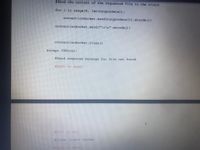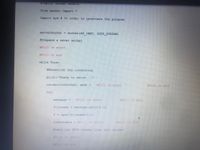
Please do not use a python code already on the internet.
The following code must be written in python for this HW assignment. I will provide a skeleten for the code and you must write some lines of code to satisfy the objective of the prorgram.
you need to develop a web server that handles one HTTP request on at a time. the web server should accept
and parse the HTTP request, get the requested file from the server’s file system, and create an HTTP response
message consisting of the requested file preceded by header lines, and then send the response directly to
the client. If the requested file is not present in the server, the server should send an HTTP “404 Not
Found” message back to the client.
Dont need the hole code just right the information and code it to the skeleten pictures below.


Trending nowThis is a popular solution!
Step by stepSolved in 2 steps with 1 images

- Write a c++ program that reads in input commands related to a queue with no more than ten elements and performs the specified operations. Note that you should create three files, one for the main, one for Queue.h, and one for Queue.cpp. Those commands are: 'E', which will be followed by a number. You should enqueue that number 'D', which will dequeue the value from the front of the queue and print it, followed by a new line 'K'. which will peek at the value at the front of the queue and print it, followed by a new line 'Q', which will quit the program You can assume that all the input is valid.arrow_forward. You have a shopping list of some items. You want to substitute one of the items with some other items. Write a script that does that. For example: Your old shopping list is: ['apple', 'pear', 'orange', 'grape'] Enter 3 new items: banana peach kiwi Enter the item to be replaced: orange New list: ['apple', 'pear', ['banana', 'peach', 'kiwi'], 'grape']arrow_forwardWrite a shell script (largest.sh) to display the largest number in a list of numbers specified as command line arguments. For example: ./largest.sh 4 6 9 2 The largest number is 9 Note: Your program should be applicable for arbitrary number lists but not just for 4 6 9 2 in above example. As long as a list of numbers is given, your program should return the largest value inside the list. The number of elements in the argument list may not necessarily be 4. The runner of your program can give as many numerical arguments as he/she wants to. You can assume that all the input arguments can be interpreted as valid numerical values.arrow_forward
- write a python code named get_total_cases() takes the a 2D-list (similar to database) and an integer x from this set {0, 1, 2} as input parameters. Here, 0 represents Case_Reported_Date, 1 represents Age_Group and 2 represents Client_Gender (these are the fields on the header row, the integer value represents the index of each of these fields on that row). This function computes the total number of reported cases for each instance of x in the text file, and it stores this information in a dictionary in this form {an_instance_of_x : total_case}. Finally, it returns the dictionary and the total number of all reported cases saved in this dictionary. (Suppose we want to know the total number of cases reported on each date, so use x = 0.) >>> result, total_cases = get_total_cases(database, 0) >>> display_dict(result) 2021-05-19: 8 2021-05-20: 2 2021-05-21: 1 2021-05-22: 1 >>> print(total_cases)arrow_forwardpython: In the Python terminal, the command dir(list) returns a list of operations that can be performed on lists. choose three (3) operations from this list and, in your own words, describe what it does, how to use it, and give your own example. Try to choose operations that have not been completed yet.arrow_forwardProvide full C++ code Building a playlist (of songs) using a linked list and making some operations such as adding songs, removing songs, shuffling them, etc. (Some parts of this lab will closely follow lab 08 - it is imperative that you complete that lab before working on this project). A Node representing a song has the following data members (similar to struct Node of lab 08, except it doesn't have one member for storing data): string uniqueID string songName string artistName int songLength Node* nextNodePtr Your code must have the following three files: Playlist.h - Class declaration for a linked list of Nodes (very similar to lab 08 but with some changes to methods, as described below) with following private data members: private:Node* first;Node* last;int size; Playlist.cpp - Class definition main.cpp - main() function Checkpoint A For checkpoint A, you need to build a playlist (of songs) by readings data members of several songs from a file and printing them. Implement…arrow_forward
- The same professor writes a program to analyze the chat logs from the various lectures as a partial measure of class participation. Each chat log consists of multiple lines, each of form TIME, NAME, COMMENT, in the order in which they were posted to the chat . The algorithm then sorts all that data - across all the chat logs - in order of student names, and scores each set using a metric based on the number of contributions and their length. [a] What are the various input sizes to consider when analyzing the algorithmic approaches? (One is the number of students in the class, but that is not the only factor.) [b] Which sorting algorithm do you think is best suited for the sorting portion of this algorithm and why? [c] What is the time complexity of the sorting algorithm chosen in step [b] as a function of the various input sizes identified in step [a]? [d] What is the overall time complexity of the chat analysis program as described above?arrow_forwardHello, I have an assignment in the python program. Professor gives me a text like this: January.txt 217283921200.5619.18,29.15,78.75,212.10100,20,410.29 The first line is an account number, the second line is the beginning balance, the third line is withdrawn and the last line is deposits. How can I separate every single line to read them. Can I use the loop function? Below is the assignment direction. Thank you very much ___________________________________________________________ Complete the following program: a) Read in and store the data from the file called “January.txt”. This file includes the customer’s account number, beginning balance, withdrawals, and deposits. (In that order) Note: Make sure you look at the file before you begin the project! b) Prompt the user for his/her name and age. c) Convert the customer’s name to a username that consists of the first letter of the first name, the first 5 digits of last name, and the customer’s age.(All letters should be lowercase)…arrow_forwardin c++ codearrow_forward
- Given Triangle struct (in files Triangle.h and Triangle.c), complete main() to read and set the base and height data members of triangle1 and of triangle2, determine which triangle's area is smaller, and output that triangle's info, making use of the relevant Triangle functions. Ex: If the input is: 3.0 4.0 4.0 5.0 where 3.0 is triangle1's base, 4.0 is triangle1's height, 4.0 is triangle2's base, and 5.0 is triangle2's height, the output is: Triangle with smaller area: Base: 3.00 Height: 4.00 Area: 6.00 412800.2778464.qx3zqy7 LAB ACTIVITY 1 #include 2 3 #include "Triangle.h" 8 9 5 int main() { 6 7 Triangle triangle1 = InitTriangle(); Triangle triangle2 = InitTriangle(); PANNENDE 10 double userBase; 9.11.1: LAB: Triangle area comparison 11 double userHeight; 12 13 14 // TODO: Read and set base and height for triangle1 (use SetBase () and SetHeight()) 15 // TODO: Read and set base and height for triangle2 (use SetBase () and SetHeight()) 16 Current file: main.c 17 0/10 Load default…arrow_forwardpythonarrow_forwardHello, I am practicing code in my Python book and I am struggling to define the submit and clear buttons for this Address Entry Form. It isn't working and states that they aren't defined. I also cannot get the 'sunken' effect look on the window frame. Can you help? My code is below. # Import tkinter import tkinter as tk # Define the submit button with a function def submit(): print("First Name: %s\nLast Name: %s\nAddress Line 1: %s\nAddress Line 2: %s\nCity: %s\nState/Province: %s\nCountry: %s" % (e1.get(), e2.get(), e3.get(), e4.get(), e5.get(), e6.get(), e7.get())) # Define the clear button with a function def clear(): e1.delete(0, 'end') e2.delete(0, 'end') e3.delete(0, 'end') e4.delete(0, 'end') e5.delete(0, 'end') e6.delete(0, 'end') e7.delete(0, 'end') # Create the master title master = tk.Tk()master.title("Address Entry Form") # Create the 'sunken' look for the window frame sunken_frame = tk.Frame(master, relief=tk.SUNKEN) # Create the labels…arrow_forward
 Database System ConceptsComputer ScienceISBN:9780078022159Author:Abraham Silberschatz Professor, Henry F. Korth, S. SudarshanPublisher:McGraw-Hill Education
Database System ConceptsComputer ScienceISBN:9780078022159Author:Abraham Silberschatz Professor, Henry F. Korth, S. SudarshanPublisher:McGraw-Hill Education Starting Out with Python (4th Edition)Computer ScienceISBN:9780134444321Author:Tony GaddisPublisher:PEARSON
Starting Out with Python (4th Edition)Computer ScienceISBN:9780134444321Author:Tony GaddisPublisher:PEARSON Digital Fundamentals (11th Edition)Computer ScienceISBN:9780132737968Author:Thomas L. FloydPublisher:PEARSON
Digital Fundamentals (11th Edition)Computer ScienceISBN:9780132737968Author:Thomas L. FloydPublisher:PEARSON C How to Program (8th Edition)Computer ScienceISBN:9780133976892Author:Paul J. Deitel, Harvey DeitelPublisher:PEARSON
C How to Program (8th Edition)Computer ScienceISBN:9780133976892Author:Paul J. Deitel, Harvey DeitelPublisher:PEARSON Database Systems: Design, Implementation, & Manag...Computer ScienceISBN:9781337627900Author:Carlos Coronel, Steven MorrisPublisher:Cengage Learning
Database Systems: Design, Implementation, & Manag...Computer ScienceISBN:9781337627900Author:Carlos Coronel, Steven MorrisPublisher:Cengage Learning Programmable Logic ControllersComputer ScienceISBN:9780073373843Author:Frank D. PetruzellaPublisher:McGraw-Hill Education
Programmable Logic ControllersComputer ScienceISBN:9780073373843Author:Frank D. PetruzellaPublisher:McGraw-Hill Education





